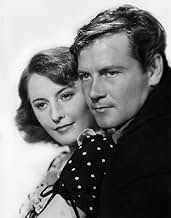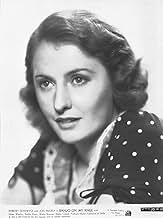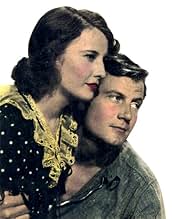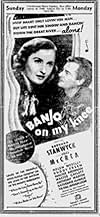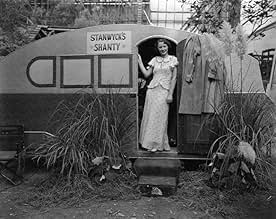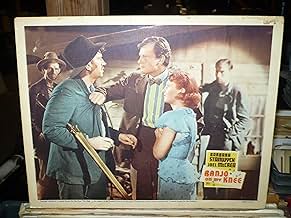- Nominated for 1 Oscar
- 1 win & 1 nomination total
Tony Martin
- Chick Bean
- (as Anthony Martin)
Katherine DeMille
- Leota Long
- (as Katherine De Mille)
Hall Johnson Choir
- Vocal Ensemble
- (as The Hall-Johnson Choir)
Herbert Ashley
- Minor Role
- (uncredited)
Fred Behrle
- Minor Role
- (uncredited)
- Director
- Writers
- All cast & crew
- Production, box office & more at IMDbPro
Featured reviews
Banjo On My Knee could be considered a transitional film for the newly created 20th Century Fox. Before 20th Century Pictures merged with Fox Film Corporation in 1936, Fox films stock in trade were these rustic type movies that starred either Will Rogers or Janet Gaynor or both even.
When Darryl Zanuck took over the new studio he changed the look entirely and 20th Century Fox became known for some splashy musicals. Banjo On My Knee is a hybrid of both the old and new studio.
Barbara Stanwyck and Walter Brennan take on parts that would have been reserved for Janet Gaynor and Will Rogers previously. Stanwyck is a land girl and she marries Brennan's son Joel McCrea. Brennan and the whole clan live on a houseboat that is moored to a sandbar island in the middle of the Mississippi. These folks don't work, they just drop a line into the Mississippi for food a few times a day.
But the wedding night is eventful because before Joel and Barbara can get to the consummation business, Victor Klllian gets fresh with Stanwyck and McCrea knocks him into the river. Thinking he's killed Killian, McCrea skedaddles to New Orleans and joins the crew of an outbound freighter.
That sets in motion a series of events that keep Joel and Barbara from doing the deed. Not like there isn't other people interested in them. Barbara attracts the attention of Tony Martin in one of his early films and Joel already had a slinky and jealous Katharine DeMille, another river girl who'd like very much to move in where Stanwyck left off.
As for Brennan he wants these two to start kanoodling because he wants real bad to be a grandfather. They all wind up in New Orleans and then back up the Mississippi on their sandbar houseboat home.
I'm betting that Henry Fonda wasn't available so Joel McCrea was signed for this film. This is just the kind of part Fonda was specializing in doing in his early career. Others in the cast include Helen Westley as a pipe smoking grandma and Walter Catlett as a smarmy photographer who gets his clock cleaned several times for trying to move in on Stanwyck.
There were original songs written for this film by Jimmy McHugh and Harold Adamson, Tony Martin gets to sing a duet with Barbara Stanwyck who admittedly did not have much of a singing voice. Martin carries the brunt of that duet. Buddy Ebsen's presence is almost mandatory in a film about rural rustics and he contributes some dance numbers. Another player who specialized in rustic types is Spencer Charters and he was in Banjo On My Knee as well. I really did love the 'annulment' that he was ready to grant McCrea in order to marry Katharine DeMille.
I'm willing to make a small wager that Banjo On My Knee was a project that Fox films might have intended for Will Rogers with his role built up more than it is here. Right around the time that the studios were merging Rogers was killed in that plane crash in Alaska. Banjo On My Knee is not a bad film, but I'm betting that Will Rogers would have made it something special.
When Darryl Zanuck took over the new studio he changed the look entirely and 20th Century Fox became known for some splashy musicals. Banjo On My Knee is a hybrid of both the old and new studio.
Barbara Stanwyck and Walter Brennan take on parts that would have been reserved for Janet Gaynor and Will Rogers previously. Stanwyck is a land girl and she marries Brennan's son Joel McCrea. Brennan and the whole clan live on a houseboat that is moored to a sandbar island in the middle of the Mississippi. These folks don't work, they just drop a line into the Mississippi for food a few times a day.
But the wedding night is eventful because before Joel and Barbara can get to the consummation business, Victor Klllian gets fresh with Stanwyck and McCrea knocks him into the river. Thinking he's killed Killian, McCrea skedaddles to New Orleans and joins the crew of an outbound freighter.
That sets in motion a series of events that keep Joel and Barbara from doing the deed. Not like there isn't other people interested in them. Barbara attracts the attention of Tony Martin in one of his early films and Joel already had a slinky and jealous Katharine DeMille, another river girl who'd like very much to move in where Stanwyck left off.
As for Brennan he wants these two to start kanoodling because he wants real bad to be a grandfather. They all wind up in New Orleans and then back up the Mississippi on their sandbar houseboat home.
I'm betting that Henry Fonda wasn't available so Joel McCrea was signed for this film. This is just the kind of part Fonda was specializing in doing in his early career. Others in the cast include Helen Westley as a pipe smoking grandma and Walter Catlett as a smarmy photographer who gets his clock cleaned several times for trying to move in on Stanwyck.
There were original songs written for this film by Jimmy McHugh and Harold Adamson, Tony Martin gets to sing a duet with Barbara Stanwyck who admittedly did not have much of a singing voice. Martin carries the brunt of that duet. Buddy Ebsen's presence is almost mandatory in a film about rural rustics and he contributes some dance numbers. Another player who specialized in rustic types is Spencer Charters and he was in Banjo On My Knee as well. I really did love the 'annulment' that he was ready to grant McCrea in order to marry Katharine DeMille.
I'm willing to make a small wager that Banjo On My Knee was a project that Fox films might have intended for Will Rogers with his role built up more than it is here. Right around the time that the studios were merging Rogers was killed in that plane crash in Alaska. Banjo On My Knee is not a bad film, but I'm betting that Will Rogers would have made it something special.
"Banjo on my Knee" is a 1936 film that will keep you guessing as to which direction it's headed nearly every time there's a scene change. McCrea plays a shantytown boy who marries a land girl (Stanwyck). The patriarch of McCrea's family, played by Walter Brennan, is desperate for a grandchild. Unfortunately, Stanwyck and McCrea can't seem to get their marriage consummated. On their wedding night, they think McCrea has murdered someone (he hasn't), so McCrea takes off for six months and sees the world while his wife waits none too patiently. The day he comes home, he talks about moving the family to Aruba and says he'll go down first for a month and then send for her. The couple get into a terrible fight because Stanwyck doesn't want to be left again. The two of them then split up again - that instant. She goes to New Orleans to work for a slimy photographer, but no sooner does she get to his apartment that she bolts and takes a job as a dishwasher in a bar.
Soon, the entire population of Shantytown is in New Orleans looking for her and for McCrea. At the bar, Tony Martin is a saloon singer who falls for Stanwyck, and soon, Buddy Ebsen, another Shantytown resident, and Walter Brennan are big hits performing there, and Stanwyck is doing duets with Martin. It goes on from there.
Some of the music is great, the highlight being "St. Louis Woman" with Brennan and the Hall Johnson Choir. Martin looks and sounds like an angel - his voice is just stunning in "There's Something in the Air" and "Where the Lazy River Goes By." Stanwyck sings just like she talks - her voice is low, pleasant, and natural. The cast is uniformly good, and Katharine DeMille has a showy role as Leota, who's in love with McCrea. McCrea, of course, is tall, handsome, and boyishly gorgeous.
I wasn't expecting a musical, and in the beginning, "Banjo on My Knee" seemed like a drama, so I never was sure what I was watching. Odd though the film may be, it was loads of fun.
Soon, the entire population of Shantytown is in New Orleans looking for her and for McCrea. At the bar, Tony Martin is a saloon singer who falls for Stanwyck, and soon, Buddy Ebsen, another Shantytown resident, and Walter Brennan are big hits performing there, and Stanwyck is doing duets with Martin. It goes on from there.
Some of the music is great, the highlight being "St. Louis Woman" with Brennan and the Hall Johnson Choir. Martin looks and sounds like an angel - his voice is just stunning in "There's Something in the Air" and "Where the Lazy River Goes By." Stanwyck sings just like she talks - her voice is low, pleasant, and natural. The cast is uniformly good, and Katharine DeMille has a showy role as Leota, who's in love with McCrea. McCrea, of course, is tall, handsome, and boyishly gorgeous.
I wasn't expecting a musical, and in the beginning, "Banjo on My Knee" seemed like a drama, so I never was sure what I was watching. Odd though the film may be, it was loads of fun.
What Banjo on My Knee lacks in original story or compelling themes, it makes up for with warm, funny characters brought to life by delightful actors. Barbara Stanwyck shines as the uneducated "land girl", who marries Joel McCrea's "river boy" despite significant differences in their background and world view. Walter Brennan assays one of his best roles as McCrea's good-natured, contraption-playing father. ("When I'm low, it's music I need " he says, before launching into a song with his one-man band.) Buddy Ebsen, singing and dancing to the title tune, Walter Catlett, as a would-be lothario in hapless pursuit of Stanwyck, and Katherine DeMille, as a voluptuous harpy after McCrea, all turn in fine performances. One of the best elements in the film, however, is the music. We not only have Brennan 's rousing renditions of "Dixie" and "St. Louis Blues", but the latter tune rendered to perfection by the marvelous Hall Johnson Choir. The film doesn 't maintain the same level of charm found in its opening scenes throughout its length, but there is enough comedy and music to make Banjo on My Knee a film worth seeing.
... one of the most bizarre movie musicals ever made. As someone else mentioned, this film makes more sense if you think about when it was made - 1936 - and what it represents - the marriage of Darryl F. Zanuck's 20th Century Pictures that was aiming to make a name for itself in musicals and with well-known stars, and failing Fox Films, which had specialized in films for and about rural folk from its inception until its bankruptcy in 1935. This film was made the year after their merger and so the aims of both companies show through. What results is a rustic semi-musical about rural Southern folk starring two stars (Stanwyck and McCrea) who do their best but really don't belong here. Buddy Ebsen and Walter Brennan seem much more at home here with charming performances you'll expect given their roles in other films.
What's a shame is that Barbara Stanwyck really isn't given more to do here. What's also a shame is that Joel McCrea, an actor who is a favorite of mine, is relegated to the part of the mindless muscle. He thinks with his fists, takes actions that make no sense when those fists have consequences, is kind and even obliging to people that are obviously trying to use him, and thoughtless to those who love him.
I really liked the musical performances and I thought the tunes were quite catchy and memorable. It's just a shame more effort wasn't put into making a story that played to Stanwyck and McCrea's strengths.
What's a shame is that Barbara Stanwyck really isn't given more to do here. What's also a shame is that Joel McCrea, an actor who is a favorite of mine, is relegated to the part of the mindless muscle. He thinks with his fists, takes actions that make no sense when those fists have consequences, is kind and even obliging to people that are obviously trying to use him, and thoughtless to those who love him.
I really liked the musical performances and I thought the tunes were quite catchy and memorable. It's just a shame more effort wasn't put into making a story that played to Stanwyck and McCrea's strengths.
BANJO ON MY KNEE (20th Century-Fox, 1936), directed by John Cromwell, teams Barbara Stanwyck and Joel McCrea for the second of six times on screen. It may not be the first motion picture in which Stanwyck sings and dances (barely), but her initial one to be classified as a musical. Following the pattern taken on the idea from Edna Ferber's story, "Show Boat," later a legendary Broadway musical followed by two screen based versions (1929, 1936), BANJO ON MY KNEE, based on the novel by Harry Hamilton, has a pattern all its own.
Opening title: "Island Number 21 is little more than a sandbar in the Mississippi River, but to the shanty boat people moored there it is the world. Of what happens on shore they know little or care less. Shanty boat people firmly believe that if God had intended folks to live in towns, He would have created towns at the same time He created rocks and trees and rivers." The story opens with on a shanty boat on the Mississippi River where Judge Pope (Spencer Charters) officiates the wedding for bride and groom, Polly (Barbara Stanwyck), a "land girl," to Ernie (Joel McCrea), a "river man" and son of Newt (Walter Brennan), whose biggest wish before he dies is to become a grandfather. Among those not present at the wedding is the jealous Leota Lang (Katherine DeMille), Ernie's former girlfriend. Following a ceremony where Buddy (Buddy Ebsen) does some dancing, Mr. Slade (Victor Kilian), one of Newt's biggest buyer of animal feed, arrives, wanting to kiss the bride. The forceful kiss forces Ernie to sock Slade into the river. Fearing that he has drowned, Leota, seeing her chance to ruin Ernie's wedding night, notifies the police so he can be arrested for murder. The police arrive, forcing Ernie to leave his bride and swim away to shore. Not soon after Ernie's escape, the soaked and dripping Mr. Slade reappears, having survived drowning by floating upstream. Six months later, after traveling around Europe, Ernie returns to Pearl only to get into a heated argument causing Pearl to walk out on her "bullheaded" husband. After Pearl goes away with photographer, Warfield Scott (Walter Catlett), on a promise of a job in Louisiana, both Newt and Ernie go after her. During their search, Pearl encounters a new career and partnership with Chick Bean (Anthony "Tony" Martin), singer at the Creole Cafe.
While the words and music by Jimmy McHugh and Harold Adamson are far from Oscar Hammerstein's immortal songs from "Show Boat," the songs are satisfactory for easy listening. The motion picture soundtrack includes: "With a Banjo on My Knee" (sung by Buddy Ebsen and Walter Brennan); "Where the Lazy River Goes By" (sung by Barbara Stanwyck to Joel McCrea); "There's Something in the Air" (sung by Tony Martin); W.C. Handy's "The St. Louis Blues" (sung by Theresa Harris/the Hall Johnson Choir); "Four Leaf Clover" "Oh, Susannah" (by Stephen Foster/ played on "contraption" by Walter Brennan); "Swanee River" (by Stephen Foster); "Where the Lazy River Goes By" (reprised by Stanwyck and Martin); "With a Banjo on My Knee" (sung/danced by Ebsen)"Swanee River" (danced by Ebsen and Stanwyck); and "With a Banjo On My Knee."
Though not in the same level as Universal's second presentation of SHOW BOAT (1936) starring Irene Dunne and Allan Jones, nor the curiosity of the seldom seen MISSISSIPPI (Paramount, 1935) featuring the likes of Bing Crosby and WC Fields, BANJO ON MY KNEE is routinely done. Song interludes provide good showcases for its performers, and a great surprise for many getting a glimpse of Stanwyck singing a song or two in ballad style, and dancing with Buddy Ebsen. Of the many tunes, Tony Martin's rendition of "There's Something in the Air" comes off best. The "St. Louis Blues" number, done in black spiritual style, begins in a similar fashion of "Ol' Man River" from SHOW BOAT. There's no Paul Robeson to stop the show here this time around, but Theresa Harris sharing her vocals with the Hall Johnson Choir, and quite effectively, too. Another highlight is Walter Brennan playing an assortment of old time tunes on his "contraption," and Walter Catlett constant avoiding a sock on the jaw.
In support is Helen Westley, through her limitations, stands out as the old granny in a rocking chair smoking a corn cob pipe and screeching a hideous laugh in the manner of an old hag. Then there's Minna Gombell, whose characterization is a close reminder of Gladys George. In the role of Ruby, a tough talking café girl, she becomes romantically involved with Ernie (McCrea) at one point, unknown that he's a married man.
Even during the broadcast TV generation of the 1960s and 70s, BANJO ON MY KNEE had its limitations, especially when last seen on the afternoon movie presentation in the New York City area where it was last seen as far back as 1970 on WOR, Channel 9. I didn't get to see this one again until the early stages of American Movie Classics cable channel prior to 1988, where it hasn't been revived since. BANJO ON MY KNEE did have some broadcasts in later years on the Fox Movie Channel. Even with occasional revivals, particularly Turner Classic Movies (TCM premiere: December 12, 2012), it's still not enough to become a well-known factor of thirties cinema.
BANJO ON MY KNEE may not win any merits as the finest musical with the most original story ever put on film, but does benefit greatly from some fine atmospheric settings depicting both Mississippi and Louisiana, folksy humor and fine chemistry between Stanwyck and McCrea to make this rarity something to consider. (*** banjos)
Opening title: "Island Number 21 is little more than a sandbar in the Mississippi River, but to the shanty boat people moored there it is the world. Of what happens on shore they know little or care less. Shanty boat people firmly believe that if God had intended folks to live in towns, He would have created towns at the same time He created rocks and trees and rivers." The story opens with on a shanty boat on the Mississippi River where Judge Pope (Spencer Charters) officiates the wedding for bride and groom, Polly (Barbara Stanwyck), a "land girl," to Ernie (Joel McCrea), a "river man" and son of Newt (Walter Brennan), whose biggest wish before he dies is to become a grandfather. Among those not present at the wedding is the jealous Leota Lang (Katherine DeMille), Ernie's former girlfriend. Following a ceremony where Buddy (Buddy Ebsen) does some dancing, Mr. Slade (Victor Kilian), one of Newt's biggest buyer of animal feed, arrives, wanting to kiss the bride. The forceful kiss forces Ernie to sock Slade into the river. Fearing that he has drowned, Leota, seeing her chance to ruin Ernie's wedding night, notifies the police so he can be arrested for murder. The police arrive, forcing Ernie to leave his bride and swim away to shore. Not soon after Ernie's escape, the soaked and dripping Mr. Slade reappears, having survived drowning by floating upstream. Six months later, after traveling around Europe, Ernie returns to Pearl only to get into a heated argument causing Pearl to walk out on her "bullheaded" husband. After Pearl goes away with photographer, Warfield Scott (Walter Catlett), on a promise of a job in Louisiana, both Newt and Ernie go after her. During their search, Pearl encounters a new career and partnership with Chick Bean (Anthony "Tony" Martin), singer at the Creole Cafe.
While the words and music by Jimmy McHugh and Harold Adamson are far from Oscar Hammerstein's immortal songs from "Show Boat," the songs are satisfactory for easy listening. The motion picture soundtrack includes: "With a Banjo on My Knee" (sung by Buddy Ebsen and Walter Brennan); "Where the Lazy River Goes By" (sung by Barbara Stanwyck to Joel McCrea); "There's Something in the Air" (sung by Tony Martin); W.C. Handy's "The St. Louis Blues" (sung by Theresa Harris/the Hall Johnson Choir); "Four Leaf Clover" "Oh, Susannah" (by Stephen Foster/ played on "contraption" by Walter Brennan); "Swanee River" (by Stephen Foster); "Where the Lazy River Goes By" (reprised by Stanwyck and Martin); "With a Banjo on My Knee" (sung/danced by Ebsen)"Swanee River" (danced by Ebsen and Stanwyck); and "With a Banjo On My Knee."
Though not in the same level as Universal's second presentation of SHOW BOAT (1936) starring Irene Dunne and Allan Jones, nor the curiosity of the seldom seen MISSISSIPPI (Paramount, 1935) featuring the likes of Bing Crosby and WC Fields, BANJO ON MY KNEE is routinely done. Song interludes provide good showcases for its performers, and a great surprise for many getting a glimpse of Stanwyck singing a song or two in ballad style, and dancing with Buddy Ebsen. Of the many tunes, Tony Martin's rendition of "There's Something in the Air" comes off best. The "St. Louis Blues" number, done in black spiritual style, begins in a similar fashion of "Ol' Man River" from SHOW BOAT. There's no Paul Robeson to stop the show here this time around, but Theresa Harris sharing her vocals with the Hall Johnson Choir, and quite effectively, too. Another highlight is Walter Brennan playing an assortment of old time tunes on his "contraption," and Walter Catlett constant avoiding a sock on the jaw.
In support is Helen Westley, through her limitations, stands out as the old granny in a rocking chair smoking a corn cob pipe and screeching a hideous laugh in the manner of an old hag. Then there's Minna Gombell, whose characterization is a close reminder of Gladys George. In the role of Ruby, a tough talking café girl, she becomes romantically involved with Ernie (McCrea) at one point, unknown that he's a married man.
Even during the broadcast TV generation of the 1960s and 70s, BANJO ON MY KNEE had its limitations, especially when last seen on the afternoon movie presentation in the New York City area where it was last seen as far back as 1970 on WOR, Channel 9. I didn't get to see this one again until the early stages of American Movie Classics cable channel prior to 1988, where it hasn't been revived since. BANJO ON MY KNEE did have some broadcasts in later years on the Fox Movie Channel. Even with occasional revivals, particularly Turner Classic Movies (TCM premiere: December 12, 2012), it's still not enough to become a well-known factor of thirties cinema.
BANJO ON MY KNEE may not win any merits as the finest musical with the most original story ever put on film, but does benefit greatly from some fine atmospheric settings depicting both Mississippi and Louisiana, folksy humor and fine chemistry between Stanwyck and McCrea to make this rarity something to consider. (*** banjos)
Did you know
- TriviaTwo of the three original songs from the movie became top ten hits on the music charts. "Where the Lazy River Goes By" went to #7 in a recording by Teddy Wilson and His Orchestra, with a vocal by Midge Williams on the Brunswick label, and "There's Something in the Air" by Shep Fields and his Rippling Rhythm Orchestra, with a vocal by Bob Goday on the Bluebird label, went to #5.
- Quotes
Pearl Elliott Holley: Shuck or be shucked
- ConnectionsFeatured in Barbara Stanwyck: Fire and Desire (1991)
- SoundtracksWhere the Lazy River Goes By
(1936)
Music by Jimmy McHugh
Lyrics by Harold Adamson
Played on harmonica by Joel McCrea and sung by Barbara Stanwyck
Performed also by Barbara Stanwyck and Tony Martin
- How long is Banjo on My Knee?Powered by Alexa
Details
- Runtime1 hour 35 minutes
- Color
- Aspect ratio
- 1.37 : 1
Contribute to this page
Suggest an edit or add missing content


